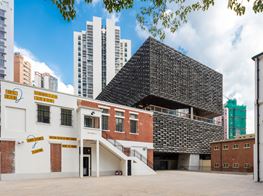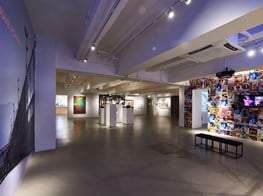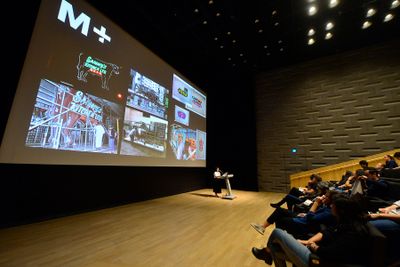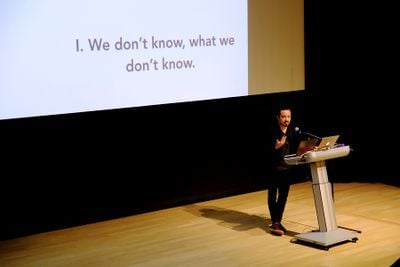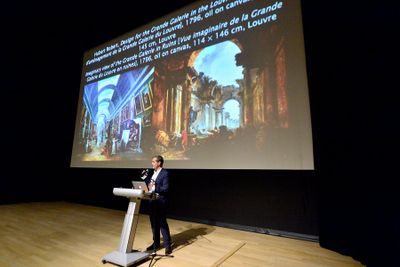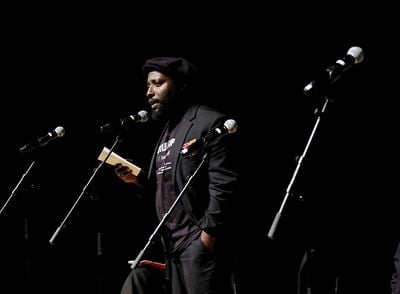Para Site International Conference Diary: Day 2
In collaboration with Para Site
The second day of What to Let Go?—Para Site's international conference at Tai Kwun – Centre for Heritage and Arts in Hong Kong—was largely focused on the subjects of artefacts and repatriation.

Tina Pang at What to Let Go?, Para Site International Conference, Tai Kwun – Centre for Heritage and Arts, Hong Kong (22–24 November 2018). Courtesy Para Site. Photo: Eddie Lam, Image Art Studio.
The day began with a local focus as Tina Pang—M+ curator of Hong Kong visual culture—presented an overview of the institution's recent history in advance of the opening of the museum's main building in West Kowloon in late 2020. She described recent off-site projects such as the museum's initiative to conserve and present historical neon signs from around Hong Kong, while acknowledging that M+ is an institution 'not devoid of bureaucracy' and things can often move more slowly than desired. The focus of her talk, however, was the 2017 M+ Pavilion exhibition Ambiguously Yours: Gender in Hong Kong Popular Culture, which presented items from Hong Kong pop culture organised through the lens of gender play. With magazine and album covers, costumes and accessories from iconic performances by late stars Anita Mui and Leslie Cheung, and artworks by artists such as Ming Wong and Chow Yiu Fai, the exhibition presented something of a partial queer narrative of Hong Kong's recent past. Notably omitted from the show and Pang's talk, however, were gender issues of present-day Hong Kong: same-sex marriage rights, official protections for trans people, and discrimination based on gender and sexual orientation.
Pang was followed by Guatemala- and London-based cultural theorist and curator Pablo José Ramírez. Through his 'messy-on-purpose' lecture, which touched on volcanoes, sci-fi films and contemporary indigenous art practices in Guatemala, Ramirez took on the problem of how to build empathy between cultures beyond neoliberal ideas of multiculturalism, which can oversimplify information about various cultural groups and their practices. Ramirez critiqued existing Western methods of translation as being in inadequate in their presumption of singular truths; instead of relying on such strategies, he said, we should focus on the gaps between languages and aim for a more chaotic 'plurilingual' mode of communication that offers no original or final meanings and allows for nomadic subjectivities.
In a powerful lecture delivered with both humour and deep gravity, curator and critic Marian Pastor Roces described her late-1990s project of taking a global inventory of Filipino artefacts found in museums outside the Philippines. She pointed out that current UNESCO repatriation conventions do not apply to Filipino ethnographic items, which were mostly acquired through scientific expeditions and circulated in an unregulated market. As such, a great wealth of artefacts has become almost completely unknown to Filipinos, and thus current political analysis remains uninformed by important aspects of Filipino history. Roces used the example of unrestituted ancient weaponry to illuminate the enormity of such information gaps, linking a long history of violence to the abhorrent brutality regularly incited by current President Duterte, whom she called a despot. Arguing that Duterte is part of a yet-under-examined lineage of violence in the Philippines, Roces concluded that the country needs to retrieve these 'lost' historical weapons to best understand contemporary weaponisations.
Unable to attend the conference, curator Mélanie Bouteloup—director of Villa Vassilieff (an alternative cultural institution opened in 2016 in Montparnasse)—pre-recorded her talk in Paris. In it, she described the political situation in her country as an identity crisis. With several generations of immigrants denied places in French society, she argued that French institutions are collapsing as a result of this exclusion. Bouteloup's talk highlighted a recent project at Villa Vassilieff in collaboration with Centre Pompidou that saw the digitisation of thousands of glass-plate photographs taken by photographer Marc Vaux of artists working in Paris in the 20th century. Through this initiative, the institution unearthed little-known histories of artists working on the peripheries of the mainstream art world; in particular, they discovered images of Chinese-born artist Pan Yuliang, who worked outside both the Chinese and French canons in Paris during the 1950s. Showing slides of Pan's work, Bouteloup asserted that it is immigrant and migrant culture that gives a city or country its vibrancy, and that only by engaging with this vitality will institutions transform.
Art historian Éric de Chassey took to the podium next and gave a talk that marked a stark shift in tone. Director of the French National Institute of Art History, de Chassey represented a far more traditional institutional perspective than other speakers. Delivering his lecture on the same day of the publishing of the report commissioned by French President Emmanuel Macron, 'The Restitution of African Cultural Heritage. Toward a New Relational Ethics'—recommending the repatriation of African artefacts gained through methods such as looting and forced consent —de Chassey asserted that France must 'go against generous impulses' and proceed with caution in the processes of return. While he acknowledged that most of these artefacts came into French hands through the presence of missionaries and colonial administrators in Africa, and via looting, he also argued that the provenance of some objects is murky. Supposing that these exceptions came into possession by non-nefarious means, de Chassey posited that it was strange that current owners 'have to be proven innocent rather than guilty'. Acknowledging that he presented a white, male and aristocratic viewpoint, de Chassey seemed to play devil's advocate to the arguments presented by previous speakers who passionately argued for the return of these post-colonial countries' histories.
The last 'lecture' of the evening was presented in 12 parts by critic, curator, author and biotechnologist Bonaventure Soh Bejeng Ndikung, aided by readers Chantal Wong and Hera Chan. The text used choking—or focusing more on consuming than chewing—as a metaphor for a crisis in which ethnological or 'world' institutions house 'stuck' artefacts in their collections: objects akin to food lodged in the throat. The day concluded with a panel discussion between speakers, moderated by Yeewan Koon, head of the Department of Fine Arts at the University of Hong Kong.
By the end of the night, it was Roces' poignant words about the importance of deeply engaging with heritage that lingered in the air: 'What is out there is unknown, we don't know what we don't know. But we could be standing on top of a blade.' —[O]

